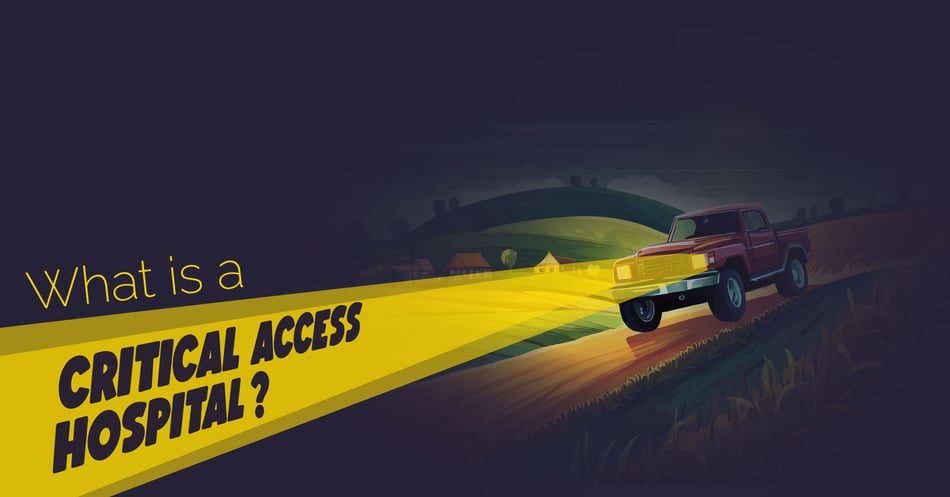What is a Critical Access Hospital?

 Critical Access Hospitals (CAHs) play an important role in today's healthcare system. Most (45) states have at least one of the over 1,300 CAHs, but states with a high proportion of rural regions depend far more on these small facilities. In today's post, we'll look at what led to the creation of this hospital designation, the vital service they provide their communities, and how they intersect with infection control and prevention issues.
Critical Access Hospitals (CAHs) play an important role in today's healthcare system. Most (45) states have at least one of the over 1,300 CAHs, but states with a high proportion of rural regions depend far more on these small facilities. In today's post, we'll look at what led to the creation of this hospital designation, the vital service they provide their communities, and how they intersect with infection control and prevention issues.
The survival of small, rural hospitals has been closely tied to decisions made at the federal level. In 1946, the Hill-Burton Act plus the increase in private health insurance led to a boom in hospital construction from rural areas to city centers. However, the 1982 Tax Equity and Fiscal Responsibility Act fundamentally changed reimbursement methods while at the same time shifts in healthcare meant less dependence on hospitals for primary care and a shift to outpatient services. The result was a huge decline in rural hospitals, with over 400 closing in just one decade, with hundreds more predicted due to the financial pressures from managed care plans and HMOs. As a result, the federal government included a Critical Access Hospital designation in the 1997 Balanced Budget Act, shielding small hospitals from financial vulnerability while improving access to health care by retaining services in rural areas. To support these CAHs, Congress also passed the Medicare Rural Hospital Flexibility Program (Flex Program) to address the financial concerns of a small facility more directly.
What are the requirements for CAH eligibility? In general, CAHs are small, remote, and provide only short-term treatment. Here is how they compare to the average community hospital.
| Critical Access Hospital | National Average | |
| Number of beds | 25 or fewer | 130 |
| Distance from another hospital | 35 miles or more or 15 miles in mountainous or no highway areas | 33 |
| Average length of stay | 96 hours or less (4 days) | 132 hours (5.5 days) |
If these eligibility requirements are met, CAHs must provide these services at a minimum:
- 24/7 emergency services
- Physician available within 30 minutes or 60 minutes for "frontier area" designated zones
- Registered nurse on site at all times if acute patient is admitted, otherwise a Licensed Practical Nurse
- Equipment and medications required for essential medical treatment
- Agreements in place with larger hospitals for patient transport
Eligible hospitals that receive CAH designation have different requirements but must still maintain quality assurance and quality improvement programs. They must have arrangements with another CAH or a network facility to monitor, assess, identify, and deliver quality improvement activities or have a quality improvement organization (or equivalent) or state-approved accrediting body. The Flex Program requires CAHs participate in the Medicare Beneficiary Quality Improvement Project, resulting in 99% of CAHs reported data in at least one domain and 93% reported in at least three.
Do CAHs have to report Hospital Acquired Infections rates? It depends on the state's Flex Program requirements. Out of the 45 Flex Program states, 34 require reporting of at least one of the National Healthcare Safety Network HAIs, but 12 of those states only require it for CAHs that are part of the Prospective Payment System (PPS). CAHs are most likely to report data on Clostridium difficile infections (CDI) and MRSA. A comprehensive report, available here, indicates that there is some lack of clarity when it comes to who needs to report what. CAHs are exempt from participating in the Healthcare Associated Conditions Reduction Program, however, and do not have reimbursements from CMS withheld.
How are CAHs affected by HAIs? While we may not have the robust data from CAHs as we would from a traditional hospital, CAHs have to deal with infections as would any other hospital, just in a different way. In a future post, we will explore how infection prevention and control is different and the same at a critical access hospital.
Do you have experience with a Critical Access Hospital? Share your thoughts in the comments below!
![EOScu Logo - Dark - Outlined [07182023]-01](https://blog.eoscu.com/hubfs/Eoscu_June2024/Images/EOScu%20Logo%20-%20Dark%20-%20Outlined%20%5B07182023%5D-01.svg)
